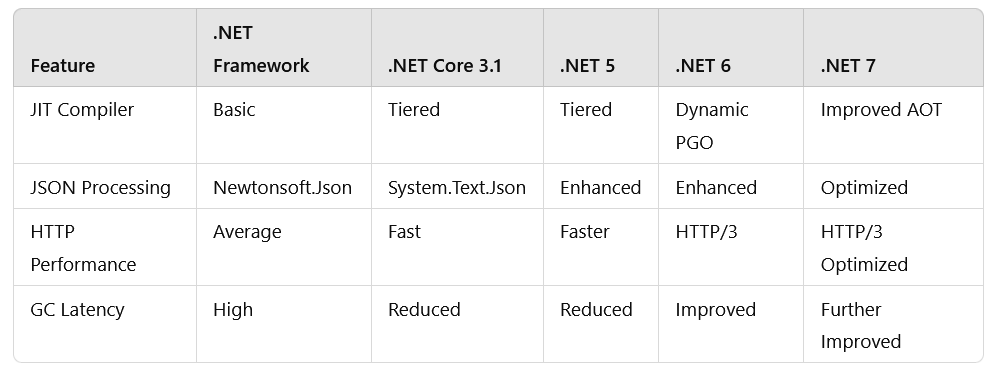Performance Evolution in .NET: How Each Version Makes It Faster
Breaking Down the Performance Boosts Across .NET Versions
Microsoft has consistently improved the performance of .NET with each release, making it a powerful framework for building modern applications. From faster runtime optimizations to enhanced memory management, every version brings innovations that improve speed, scalability, and efficiency.
In this blog, we’ll explore how .NET achieves performance improvements across versions, breaking it down into key areas like the runtime (CLR), JIT compiler, Garbage Collector, and language features.
1. Faster Just-In-Time (JIT) Compilation
The JIT compiler converts your Intermediate Language (IL) code into machine code at runtime. Each .NET version enhances the JIT compiler for better performance.
Improvements:
Tiered Compilation:
Introduced in .NET Core 2.1, it allows the JIT to compile code quickly at first, then optimize it further after usage data is collected.
Hardware-Specific Optimizations:
.NET leverages newer CPU instructions like SIMD (Single Instruction, Multiple Data) for faster vector operations.
Dynamic PGO (Profile-Guided Optimization):
Introduced in .NET 6, this feature collects runtime behavior data to make better optimization decisions.
Real-World Impact:
Loops, mathematical operations, and data processing tasks execute faster with these optimizations.
👋 Become 1% better at .NET Full Stack development every day.
👆 https://dotnet-fullstack-dev.blogspot.com/
♻ Restack it Vibe matches, help others to get it
2. Improvements in Garbage Collection (GC)
The Garbage Collector (GC) manages memory by automatically freeing unused objects. Each .NET release brings enhancements to reduce pause times and improve throughput.
Key Enhancements:
Server GC:
Provides better scalability for multi-threaded environments.
Background GC:
Introduced to minimize interruptions by performing collection concurrently with application execution.
Ephemeral GC Optimizations:
Improves handling of short-lived objects, reducing GC overhead.
Real-World Impact:
Applications with heavy memory usage, like web servers and game engines, benefit from smoother performance and reduced latency.
3. Performance-Focused APIs
.NET continuously introduces new APIs and improves existing ones for speed and efficiency.
Examples:
Span<T>andMemory<T>:Introduced in .NET Core, these types enable efficient memory access without allocations.
System.Text.Json:A high-performance JSON serializer and deserializer, introduced in .NET Core 3.0, is much faster and leaner than
Newtonsoft.Json.
File I/O Enhancements:
Faster file reads and writes with improved buffering in .NET 6.
Real-World Impact:
Developers can process large datasets or handle JSON serialization faster and with reduced memory usage.
4. Ahead-Of-Time (AOT) Compilation
Ahead-Of-Time compilation converts IL code into native code before deployment, bypassing the JIT process.
Key Features:
ReadyToRun (R2R):
Improves startup times by pre-compiling parts of the application.
Native AOT:
Introduced in .NET 7, it generates self-contained, highly optimized executables.
Real-World Impact:
AOT is ideal for scenarios like serverless functions, IoT, or CLI tools where startup time is critical.
5. Optimized HTTP/Networking Stack
Networking and HTTP handling have seen major performance gains in recent versions.
Key Improvements:
Sockets and Kestrel:
Kestrel (the default ASP.NET Core web server) has become one of the fastest web servers available, with reduced latency and better scalability.
HTTP/2 and HTTP/3:
Support for HTTP/2 and experimental HTTP/3 brings faster web communication with reduced latency and improved multiplexing.
Real-World Impact:
ASP.NET Core applications benefit from lower response times and higher throughput.
6. Language Features That Improve Performance
C# introduces features that directly or indirectly enhance performance.
Examples:
asyncandawait:Asynchronous programming improves responsiveness without blocking threads.
recordTypes (C# 9):Lightweight and faster object initialization.
Pattern Matching Enhancements:
Makes code more concise and potentially more performant.
Real-World Impact:
Applications with high concurrency or heavy data manipulation become more efficient.
7. Reduced Footprint and Faster Deployment
.NET continuously reduces runtime overhead and improves deployment options.
Key Enhancements:
Single-File Executables:
Bundling all dependencies into a single file for easier deployment (introduced in .NET 5).
Trimmed Executables:
Removes unused assemblies and dependencies to reduce size (introduced in .NET Core 3.0 and improved in .NET 6).
Real-World Impact:
Smaller container images and faster deployment times, especially in cloud environments.
8. Benchmarks Across Versions
Here’s a summary of how .NET performance has evolved:
Explaining to a Beginner
Think of .NET as a car. Every version improves:
Engine Efficiency (runtime and JIT optimizations).
Fuel Economy (memory management and GC).
New Features (better APIs and language tools).
Speed on Highways (networking and HTTP performance).
With every release, Microsoft tunes the engine, adds new gears, and ensures your journey (application performance) is smoother and faster.
Conclusion
.NET’s continuous performance improvements make it one of the best frameworks for modern application development. From runtime optimizations to developer-friendly APIs, every version ensures your applications run faster, scale better, and deploy more easily.
Ready to harness the power of .NET’s latest version? Dive into the documentation or start experimenting today! 🚀
Have you noticed performance gains in your .NET projects? Share your experiences below!



